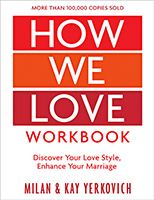This month we wrap up our discussion of Milan & Kay Yerkovich’s book titled, “How We Love”. It shows how crucial our early childhood experiences are and how they impact how we give and receive love even today as adults. Last month we looked at two of the four love styles that impair how we love others, especially our spouse—The Avoider Style and The Pleaser Style. This month we will examine The Vacillator Style and The Chaotic (Controller & Victim) Style.
The Vacillator Love Style
The Home Environment
People imprinted to be vacillators commonly experience periods of abandonment growing up. At times their parents truly connect with them, but consistency is difficult. Mom or Dad suddenly disengage, becoming absorbed in their own emotions or interests, and thus are unavailable to their children. Engaging in the parental role only when they are in the mood, they wind up giving their children a mixed message: “Come close…No, go away!” The unspoken message received by a child but not understood is ” Be available and need me when I feel like parenting, but survive on your own when I don’t.”
What’s it Like to Be the Kid?
Erratic interactions with parents leave children confused and hyperattuned to signs of connection and abandonment. These kids become acutely sensitive to the emotional temperature of other people and learn to adjust their behavior accordingly. Preoccupied with reading the signals, they become discouraged and angry because they can’t figure out how to get attention when they need it. These children have experienced enough connection to desire more, and they are frustrated by their futile efforts to receive attention when they need it. Unable to achieve the connection they desire, they feel unwanted to some degree or another.
IMPRINTED WITH A VACILLATOR LOVE STYLE
| Child’s Needs | Child’s Expression | Parental Response | Child’s Reaction | Vacillator Characteristics |
|---|---|---|---|---|
| Parent sometimes sees the child and sometimes does not. The focus is on the parent’s needs and whims for emotional availability. | Becomes limited, extreme, or sporadic after trying to read mood of parent. | Inconsistent and unpredictable. Child is left to wait for connection, which is governed more by the parent’s mood than the child’s need. | Child becomes confused and hypervigilant to try to predict and control relationship. Angry and anxious at having to wait. | Looking for intense, consistent connection. |
Common Phrases of Vacillators
“I Have a Right to Be Angry'”
“It’s Love at First Sight!”
“You Are My Soul Mate”
“I Want Out…No, I Want In”
“Why Don’t You Want Me?”
“You Hurt Me Too Much. It’s Over”
“You Are The Problem. If You Would Change, I’d Be Happy”
“Make Me Feel Special”
“If I’m Not Happy, Then Nobody’s Gonna Be Happy”
Growth Goals
If you recognize yourself as a vacillator, that’s huge—and the workbook would be most beneficial to you. Vacillators have the most difficulty seeing their part in relational problems. Understanding your love style—and changing—can mean dramatic progress toward achieving more of the deep connection and intimacy you have always desired. But first you need to recognize and take responsibility for your part. A good starting place is to be more direct about exactly what you want and need instead of believing, “If my spouse loved me, they would just know”. Learn to express the hurt instead of getting mad. Try to see both the good and bad in any person or situation instead of idealizing the situation and devaluing the other person.
The Chaotic (Controller and Victim) Love Styles
The Home Environment
The controller and the victim imprints are the result of serious problems in a child’s home. People raised in chaotic environments learn that relationships are not safe and nurturing, but rather destructive and dangerous. Often their parents struggle with numerous addictions, deal with mental illness, or are absent altogether. For these kids, parents don’t relieve stress, they create it, leaving the children with a huge dilema. They need their parents in order to survive, but their parents are the source of danger, anxiety, and fear.
Naturally strong kids learn to fight back, especially as they get older. Anger is power and preferable to humiliation, shame, fear, or grief. As these kids move into adulthood, experience has taught them to control others or be controlled. They have no other defense.
Children who are more compliant and passive learn to detach from the situation and diminish their distressing feelings by becoming invisible. They work frantically to avoid conflict and do what is expected. They cannot overcome their fear in order to push back, so, as adults, they feel powerless to assert themselves and tend to marry controllers, who reinforce their belief that asserting oneself is dangerous and useless.
What’s it Like to Be the Kid?
In the chaotic home, connection is not just unavailable or sporadic. It’s dangerous! In healthier homes, parents help when their children are anxious, but in chaotic families, the children become the target of many of their parents’ negative emotions. These parents who have a chaotic love style leave children confused, disoriented, and unable to predict what will come next. Under such circumstances they can’t learn a strategy for dealing with stress. Parents don’t tolerate their children’s expressions of sadness or anger because those emotions bring them too close to their own helplessness and the terror that remains unresolved.
IMPRINTED WITH A CHAOTIC (CONTROLLER or VICTIM) LOVE STYLE
| Child’s Needs | Child’s Expression | Parental Response | Child’s Reaction | Controller or Victim Characteristics |
|---|---|---|---|---|
| Disregarded or overwhelming to the parent | Causes outrage or withdrawal in the parent | Abuse or neglect of the child. Instead of relieving stress, parents are the source of stress. | The child is confused, which causes anxiety, anger, and fear. | Controller dominates to reduce anxiety. Victim fearfully yields to keep peace. |
Common Phrases of Controllers
“It’s Either Me or You”
“I Don’t Want You Out of My Sight”
“Don’t Question Me”
“I Didn’t Do Anything Wrong!”
“How Could You Be So Stupid?”
“I Quit My Job; My Boss Is a Jerk”
Common Phrases of Victims
“It’s Not So Bad”
“It’s My Fault”
“Anything Is Better Than Being Alone”
“It’s Hopeless”
“Numb Is Better”
“The Secret Is Safe With Me”
“I Don’t Feel Well”
“How Can I Protect The Kids When I’m Still One Myself?”
Growth Goals
Although people from chaotic backgrounds have serious relational injuries, they rarely seek help. Financial difficulties, denial, and entrenched roles contribute to stubborn patterns of unhealthy independence and self-sufficiency that are difficult to acknowledge and break. The beginning of change may only occur after the victim enters a shelter after years of domestic abuse or due to court-ordered therapy after the police or child protective services become involved. Healing cannot take place in an unsafe environment, yet few chaotic individuals (if any) have ever experienced safety, acceptance, or grace. So their first steps of growth almost always take place outside the home, where controllers, as well as victims, can experience safety and support for the first time.
What we have presented these last four months have just been short excerpts from the book. There is so much more great content and many more exercises and suggestions in the book and workbook to help you move from being an avoider, pleaser, vacillator, or controller/victim to a more secure love style. If you have identified with any of these impaired styles, I recommend you dig deeper by reading the book and completing the workbook.
This month’s post is adapted from the book, “How We Love” by Milan & Kay Yerkovich. They also have a companion workbook to help you bring lasting change to your marriage relationship through exercises and questions that did deeper into the principles shared in the book. If you want more than insight and head knowledge, I recommend reading the book and going through the workbook with your spouse. You should get one workbook for each of you since you will be filling it out and have different answers.













Leave A Comment
You must be logged in to post a comment.